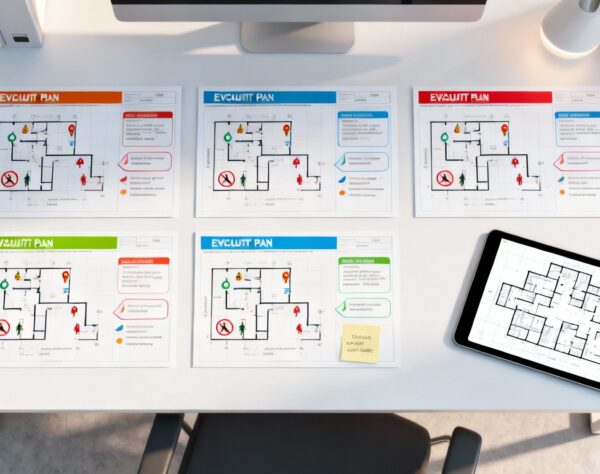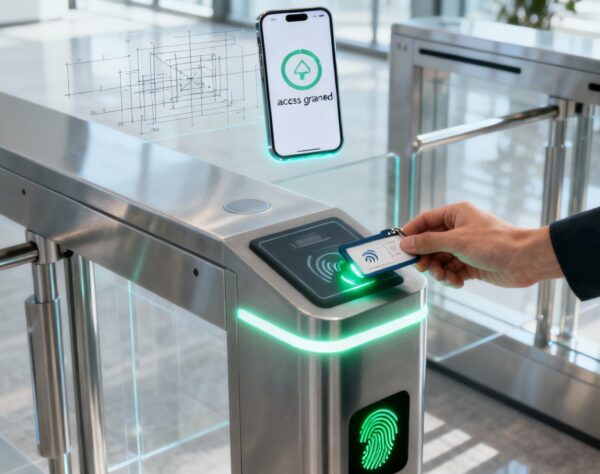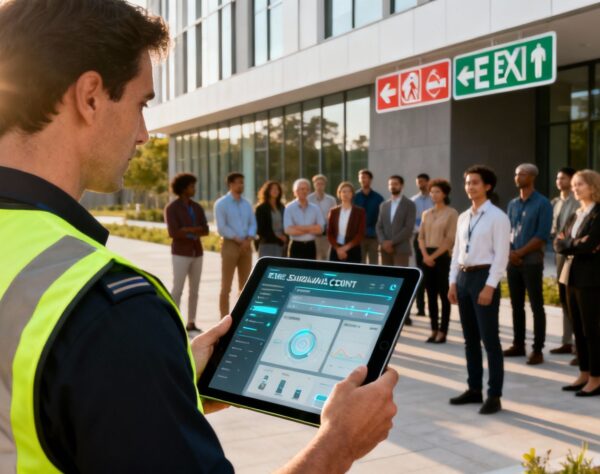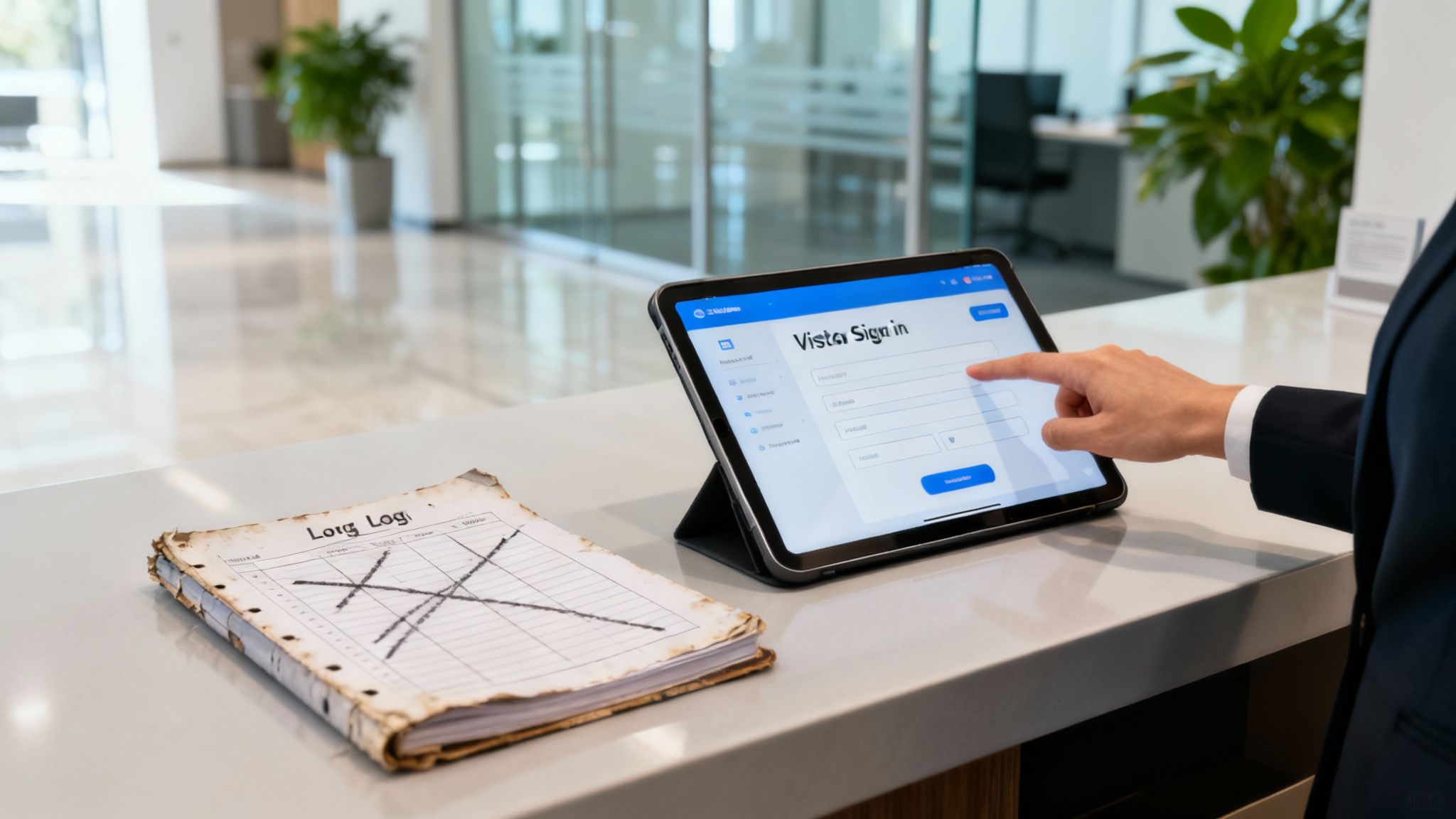
Modernize Your Visitor Log Book
A visitor log book is a record of everyone who enters and leaves your premises, capturing their name, arrival time, and purpose. For decades, this was a paper book on a reception desk. Today, that first point of contact is a critical opportunity to enhance your brand, tighten security, and streamline operations.
Why Your Welcome Experience Matters More Than Ever
The moment a visitor arrives, they form an opinion of your company. A messy paper logbook with exposed personal details suggests inefficiency. In contrast, a smooth digital check-in signals professionalism, modernity, and a commitment to privacy.
This first impression has a direct business impact. A huge 86% of buyers will pay more for a great customer experience. That experience begins at your front desk, setting the tone for every meeting, interview, or partnership.
First Impressions and Brand Identity
Your reception area is the physical introduction to your brand. A clunky, manual sign-in process creates a poor first impression and suggests your internal operations may be just as outdated. A digital visitor management system delivers immediate benefits:
- Reinforces Professionalism: A sleek tablet check-in tells visitors you are efficient, tech-savvy, and respect their time.
- Builds Trust: Securely handling visitor data demonstrates a commitment to privacy, a massive factor in building trust with clients and partners.
- Creates a Consistent Experience: A digital system ensures every visitor receives the same high-quality, branded welcome, reinforcing your company identity.
A seamless welcome experience isn't a luxury; it's a strategic necessity. Turning that first interaction from a simple sign-in into a positive brand moment sets a constructive tone for the entire business relationship.
Enhancing Safety and Providing Insights
Beyond impressions, how you log visitors has real consequences for workplace safety. In an emergency, a paper logbook is almost useless due to illegible handwriting and no quick way of knowing who is on-site.
A digital visitor log book is a critical safety tool. During an evacuation, it provides an accurate, real-time list of everyone in the building, accessible instantly on any device. This dramatically improves emergency response. The data collected also offers powerful insights into visitor traffic patterns, helping you manage your facilities more effectively. For more ideas, see our guide on how to create a welcoming reception area.
Moving from paper to digital is a fundamental shift toward a safer, more professional, and data-driven workplace.
The Hidden Risks of Using a Paper Visitor Log Book

A traditional paper visitor log book might seem harmless, but it exposes your business to serious security, legal, and operational risks. The book sits open for anyone to see a running list of visitors—a major breach of confidentiality.
This isn't just poor practice. Research shows that 87% of consumers will not do business with a company if they have concerns about its security practices. An open logbook signals a disregard for data protection, damaging trust from the moment a visitor arrives.
Compliance and Legal Vulnerabilities
In Australia, handling personal information is governed by strict laws. An insecure paper log book can put your business in direct violation of the Australian Privacy Principles (APPs). Paper records have no audit trail, making it impossible to track who has viewed sensitive information. Penalties for non-compliance are severe, with fines up to $2.5 million for serious breaches, not to mention the lasting damage to your reputation.
A paper log is a document of uncontrolled risk. Once information is written down, you lose all command over its distribution and security, creating a significant compliance gap that is difficult to defend.
For businesses wanting to avoid these issues, better options exist. You can explore structured visitor sign-in sheets, though digital solutions offer the strongest protection.
Operational Failures During Emergencies
The most critical risk of a paper log appears during an emergency. First responders need a fast, accurate list of everyone on-site, but a paper log is completely inadequate. Trying to conduct a roll call from a book filled with illegible entries and forgotten sign-outs wastes precious time when every second counts.
- Illegible Handwriting: Scribbled names are useless in a crisis.
- Missing 'Sign-Out' Times: An inaccurate headcount puts lives at risk.
- Physical Limitations: If the logbook is lost, damaged, or inaccessible during an emergency, your only record of on-site visitors is gone.
Data Integrity and Physical Security
Paper logs are easily lost, damaged, or stolen, wiping out your records with no backup. While a digital solution solves these problems, it also requires strong cyber defences. Upgrading your sign-in process should be paired with an investment in robust IT security to safeguard your data effectively. The weaknesses of a paper visitor log book represent a fundamental flaw in security, compliance, and emergency planning.
The Evolution of Visitor Management in Australia
The need to know who is on your premises is not new. The move to a digital visitor log book is the logical next step in responsibly managing sites.
Historically in Australia, early visitor tracking was tied to the country’s growth, with state railways logging passenger movements to shape tourism and infrastructure. You can find insights into this early form of systematic data collection on abs.gov.au. What began as a tool for public infrastructure is now essential for businesses facing modern challenges around security, compliance, and data privacy.
From Public Logs to Private Sector Security
As Australia's economy evolved, the paper log book became a fixture in corporate offices, factories, and government buildings. The focus shifted from demographics to basic on-site security—knowing who was in the building at any given time.
However, this pen-and-paper system remained unchanged for decades, while risks around data privacy and emergency preparedness grew. These mounting pressures highlighted the system's flaws and paved the way for a necessary technological upgrade.
The Digital Shift and Modern Business Needs
The jump to digital visitor management was a direct response to pressures that the old system couldn't handle. As Australian businesses embrace digital transformation, they face new challenges:
- Heightened Security Concerns: A greater need to control building access, screen visitors, and maintain a verifiable entry record.
- Strict Privacy Regulations: The Australian Privacy Principles (APPs) mandate how businesses must collect, store, and protect personal data.
- Efficiency and Automation: A constant drive to operate smarter by eliminating manual, error-prone tasks like paper-based sign-ins.
The modern visitor log is no longer just a record; it's an active management tool. It has evolved from a passive list of names into a dynamic system that strengthens security, ensures compliance, and enhances the overall visitor experience.
The fundamental need to know 'who is on-site' remains, but the tools we use must meet today’s demands for data security and operational intelligence. To see what these modern tools offer, explore our overview of a visitor management system in Australia.
Strategic Benefits of a Digital Visitor Log Book
Upgrading from a paper log to a digital system is a strategic business decision with measurable returns in security, compliance, and operational efficiency. It’s not about adding features; it’s about solving real-world problems that a clipboard and pen cannot.
This infographic shows how a digital system instantly enhances the check-in process.
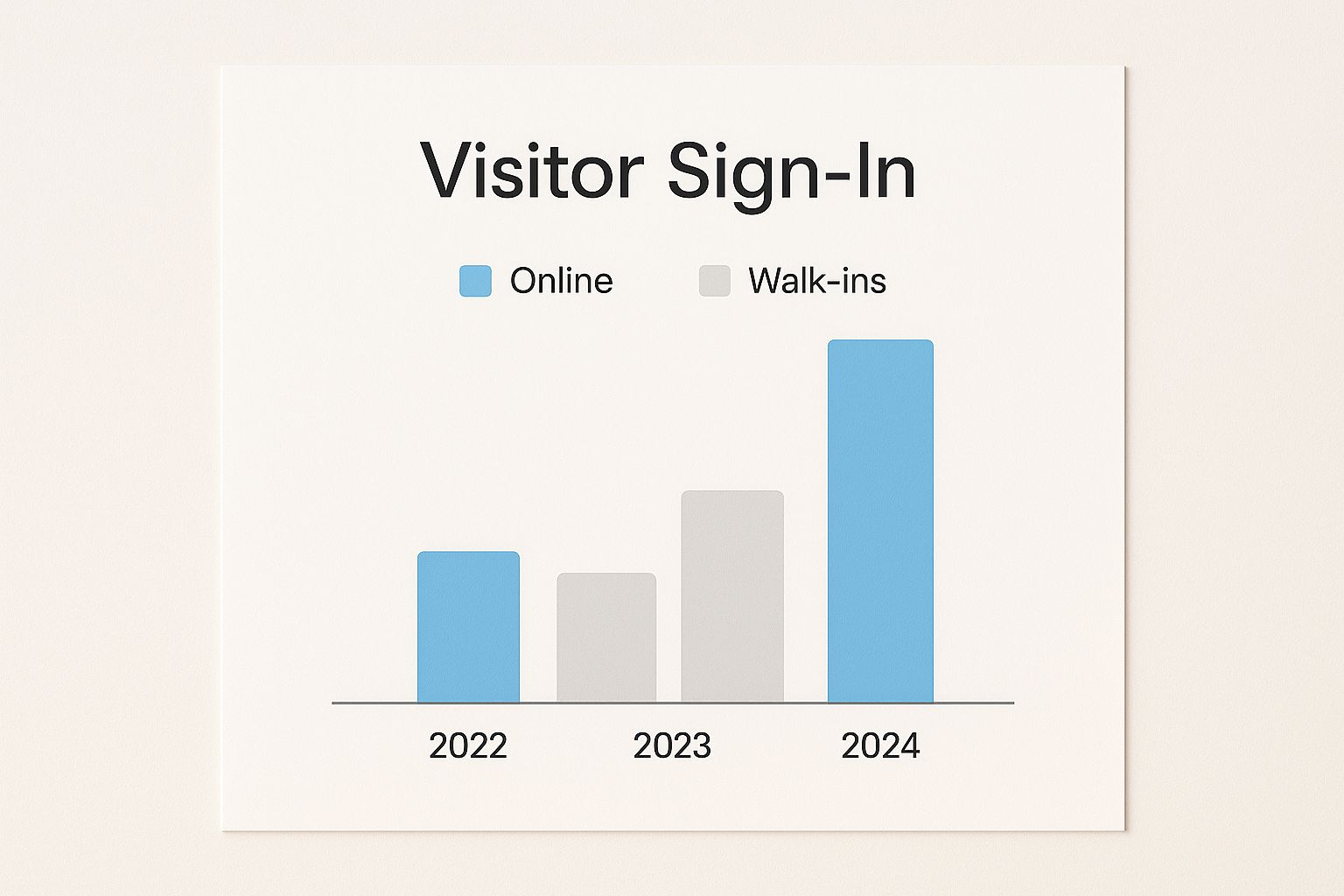
The seamless and secure experience created by a digital platform provides a significant lift to both your security posture and your visitor's first impression.
Bolstering Security and On-Site Safety
A digital system is your first line of defence, offering security benefits paper cannot match. Instant photo capture on arrival creates a visual record of everyone on your premises, which is invaluable for incident investigation. When a visitor checks in, an automatic notification with their photo is sent to their host via SMS or email. This simple step confirms the guest's arrival and alerts staff to unexpected visitors. This benefit alone can slash security incident response times by up to 40%.
A digital log transforms visitor management from a passive record-keeping task into an active security function. It provides real-time awareness and control over who is on your premises at all times, fundamentally strengthening your site's safety posture.
This proactive approach is a world away from a paper book that offers zero real-time oversight.
Streamlining Compliance and Audit Readiness
A digital system automates compliance with Australia’s privacy laws. Visitor data is encrypted and access is tightly controlled, ensuring records are stored securely and privately in line with the Australian Privacy Principles (APPs). In the event of an audit, searching digital records by name, date, or company takes seconds, delivering clean, legible reports. This efficiency is critical, as businesses face fines of up to $2.5 million for serious privacy breaches.
Driving Superior Operational Efficiency
Automating the check-in process frees up reception staff to focus on higher-value tasks. Instead of deciphering handwriting and making phone calls, visitors check themselves in, hosts are notified automatically, and records are stored securely online. This simple shift can save reception staff up to 95% of the time previously spent on visitor administration.
This benefit extends beyond the office. In Australia's tourism sector, which contributed 2.9% to GDP in 2023-24 and employed 619,500 people, efficient record-keeping is vital for both customer experience and compliance.
The table below highlights the key differences.
| Area of Concern | Paper Visitor Log Book (The Risks) | Digital Visitor Management (The Benefits) |
|---|---|---|
| Data Privacy | Sensitive visitor information is exposed on the desk for anyone to see. | All data is encrypted, access-controlled, and stored securely, meeting privacy standards. |
| Security | No real-time alerts for unexpected arrivals; records are easy to fake or tamper with. | Instant host notifications and photo capture provide active, real-time security oversight. |
| Emergency Response | Finding out who is on-site during an emergency is slow, manual, and often inaccurate. | Generates an accurate, real-time evacuation list with a single click, ensuring everyone is accounted for. |
| Audit & Reporting | Searching for records is a painful manual process, relying on illegible handwriting. | Finding specific visitor records is instant, with clean, searchable digital reports ready in seconds. |
| Staff Workload | Reception staff are tied up with manual check-ins, phone calls, and filing paper logs. | The check-in process is automated, freeing up staff to focus on more important, high-value tasks. |
| Visitor Experience | The process feels outdated and slow, creating a poor first impression of the business. | A sleek, modern, and fast check-in experience that impresses visitors from the moment they arrive. |
Ultimately, the benefits of a modern visitor management system provide a compelling business case for upgrading from outdated paper methods.
How to Choose the Right Digital System
Transitioning from a paper visitor log book to a digital system is straightforward when you focus on what matters: enhancing security and streamlining workflows. Forget complex feature lists; instead, evaluate solutions based on your specific needs in security, scalability, and user experience.
Assess Your Core Security and Compliance Needs
Every business has unique security requirements. A manufacturing plant’s needs differ from a corporate office or an aged care facility. Define what security means for your workplace first. Do you need to track contractor credentials, conduct health screenings, or simply ensure an accurate emergency list?
For any Australian business, data residency is non-negotiable.
Ensuring your visitor data is stored locally within Australia is a fundamental requirement for meeting your obligations under the Australian Privacy Principles (APPs). This simple check protects you from potential breaches and demonstrates a serious commitment to data security.
Choose a provider that guarantees Australian data hosting. This is a core feature of a trustworthy system and a major benefit over a traditional paper visitor log book.
Prioritise Scalability and Integration
The system you choose today must support your future growth. A scalable solution allows you to add new sites or check-in kiosks without a complete overhaul. Equally important is how well the system integrates with your existing tools.
- Access Control Systems: Can the system grant visitors temporary access to specific doors?
- Workplace Messaging: Does it send arrival notifications to platforms like Microsoft Teams or Slack?
- Calendar Integration: Can you pre-register visitors directly from an Outlook or Google Calendar invite?
These integrations transform a digital log book into a central operational hub, automating tasks and saving significant time. In fact, such automation can save front desk staff up to 95% of the time they once spent on visitor admin.
Focus on Ease of Use for Everyone
The best system is one that people actually use. It must be simple for visitors, contractors, and staff. A clunky interface will only cause frustration. Look for a clean, intuitive design that guides visitors through sign-in with clear instructions. The admin dashboard should be just as straightforward, allowing your team to pull reports and manage settings without needing IT support.
For a deeper dive, our guide on how to choose the right visitor management system for your business offers a detailed framework.
Ensuring a Smooth Transition to Digital
Switching from paper to a digital system is an easy operational win, but a smooth rollout depends on good planning. This is about guiding your team through a small but important change in their daily work.
The key is communication. Explain to your staff why you're making the change, focusing on the benefits that directly affect them, such as reduced administrative tasks and enhanced security. When people understand the "why," they are more likely to embrace the "how."
Preparing Your Team for Success
Solid training is the cornerstone of a successful launch. Your front-desk team are the champions of this new system, so they must feel confident using it. Schedule dedicated, hands-on training sessions covering everything from checking in visitors to running emergency reports. Let them practice with the actual hardware and software to build real confidence.
A Simple Implementation Checklist
A simple checklist can keep your transition on track and ensure no critical steps are missed before your new digital visitor log book goes live.
- Technical Setup: Configure the system with your custom branding, sign-in fields, and automatic notifications.
- Staff Training: Run dedicated training sessions for all relevant staff and provide quick-reference guides.
- Pre-Launch Communication: Inform all employees about the new process and highlight the security and efficiency benefits.
- Go-Live Day Support: Have a point person available on launch day to offer immediate help and answer questions.
The value of accurate visitor tracking is clear on a national scale. In the 2018-19 year, Australia recorded 9.3 million short-term visitor arrivals, highlighting the immense flow of people that businesses must manage. For more details, you can learn more about Australia's international travel statistics on abs.gov.au.
Your Questions Answered
Moving from a familiar paper log book can raise questions. Getting clear answers will help you make a confident decision.
Is a Digital Visitor Log Book Compliant with Australian Privacy Laws?
Yes, absolutely. A quality digital system is designed to be far more secure and compliant than any paper log. A paper book exposes personal data, while a digital platform encrypts it in a secure database, preventing unauthorised access. Reputable providers adhere to the Australian Privacy Principles (APPs) and host data locally, providing a clear audit trail that is crucial for proving compliance and avoiding fines of up to $2.5 million for serious breaches.
Will Our Visitors Find a Digital System Hard to Use?
Not at all. Modern systems feature clean, intuitive interfaces similar to airport or supermarket self-service kiosks. The process guides visitors step-by-step, making check-in fast and painless. For repeat visitors, a simple QR code scan is often all that's needed. If a guest needs assistance, your staff can easily manage the sign-in for them, ensuring a welcoming experience for everyone.
What Is the Real Return on Investment?
The ROI of a digital system extends far beyond saving on stationery. The true value comes from mitigating major business risks and improving operational efficiency. The benefits add up quickly:
- Boosted Staff Efficiency: Automating visitor management can free up front-desk staff from up to 95% of related administrative tasks.
- Tighter Security: The system acts as a proactive defence against costly security breaches and workplace incidents.
- Stronger Compliance: It provides secure, auditable records to protect you from massive fines under the Privacy Act.
- Polished Brand Image: A modern check-in process reinforces your image as a professional, forward-thinking organisation.
When combined, these benefits deliver a return that makes the subscription cost a strategic investment in your business's safety, efficiency, and reputation.
Ready to see how a modern, secure visitor management system can transform your front desk? Discover the benefits with VisitUs and provide a safer, more professional welcome for every guest. Learn more at VisitUs.


